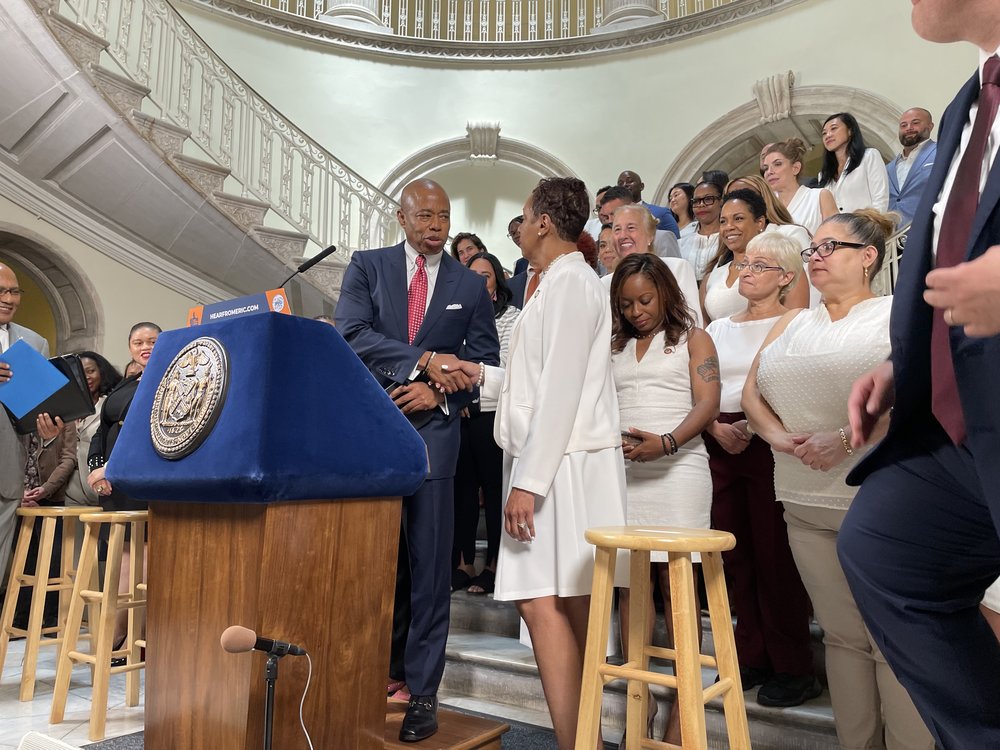Mayor Adams and Council agree to $107B budget, add funding to libraries, CUNY and senior programs
June 29, 2023, 12:48 p.m.
The deal, which came right before the July 1 deadline, represented a hard-fought battle over spending priorities as the city faces fiscal challenges.

Mayor Eric Adams and the City Council agreed on Thursday to a $107 billion city budget following tense negotiations that tempered some of the administration’s cuts, including those to libraries, CUNY and programs for seniors.
The "handshake deal" added several hundred million dollars to the mayor’s executive budget proposed in late April. Unlike last year, it was reached with little time to spare before the beginning of the next fiscal year.
It also left the public with incomplete information about the budget; the mayor’s office said it would not provide detailed spending information until the Council votes on the budget on Friday.
“The agreement we reached today comes in the midst of a budget cycle dominated by great challenges and unexpected crises, but I am proud to say that we have successfully navigated through these many crosscurrents to arrive at a strong and fiscally responsible budget,” Adams said in a statement.
“Unlike the Yankees, it was not a perfect game,” Adams said, standing in the City Hall rotunda surrounded by administration officials and councilmembers. “But we got a win for working-class New Yorkers.”
All the same, the mood of the announcement was restrained. The mayor began his remarks by shaking hands with Council Speaker Adrienne Adams — a contrast from last year, when the two lawmakers hugged at the podium.
“These negotiations were not easy,” the speaker said. “In fact, they were uniquely challenging because of how much it focused on restoring cuts to so many important programs.”
In a striking show of solidarity, the speaker and her female councilmembers were all dressed in white. They are part of the first majority female Council in city history.
The mayor and council speaker have waged a heated battle over how to tackle the city’s affordable housing crisis and finance critical initiatives such as universal pre-K, CUNY and cultural institutions. Funding for the city’s libraries, which had been facing a $36 million deficit, was restored following an aggressive campaign by councilmembers and some celebrity supporters.
Spending on city schools, which became a huge point of contention last year, drew less attention during negotiations. The mayor said that school budgets would initially remain the same, regardless of any student enrollment declines.
But some education advocates worry that schools may face midyear cuts.
When he was asked about the prospect, the mayor made no assurances.
"There's no desire to do so," he said, but added that there are "no guarantees in life."
The budget was also adjusted to allow for a cost of living increase for nonprofit workers who work for the city. A majority of those workers have earnings that are at or below the “near poverty” threshold.
Some other key takeaways for the new budget include:
- $95 million to expand Fair Fares, a program that gives discounted subway and bus rides to low-income New Yorkers. City leaders increased the program's qualification threshold to 120% of the federal poverty level, which is far less than the 200% advocates called for
- Restoring $32 million for CUNY
- Adding 5,000 slots to the city’s Summer Youth Employment Program, to allow school-year employment opportunities
- $184 million for crisis response and violence prevention programs
- $100 million for a city hospital program that provides free and low-cost health care to New Yorkers who cannot afford or do not qualify for insurance
The next fiscal year — which begins on July 1 — will arrive as the city contends with a host of financial challenges that could lead to large deficits in future years. The city’s economic growth is expected to slow at the same time that billions of dollars in federal pandemic aid are set to expire. Costs from expensive labor contracts that Adams settled this year and an influx of migrants have also strained spending.
The administration projects that the accumulated costs of the migrant crisis will climb over $4 billion in the upcoming year.
At the same time, many New Yorkers are struggling to meet their basic financial needs amid skyrocketing rents and food prices in an uncertain economy that is still recovering from the pandemic.
Adams had called for belt-tightening and issued sweeping cuts across multiple city agencies that affected some widely popular services, including public libraries and home-delivered meals for seniors.
The Council rallied against the cuts, arguing that they were too severe and that the city still showed stronger than expected revenues.
Earlier this month, tensions reached a tipping point when the Council passed a package of housing-focused bills in response to not seeing similar financial aid in the budget. The mayor vetoed these bills – only the second time he’s done so since starting his term – in an extraordinary show of opposition that appears headed for a court battle.
Next year’s budget negotiations are poised to become more difficult as the city must decide how to pay for popular programs — such as pre-K and summer school — that have been buoyed by federal pandemic funding.
The upcoming budget sets aside $8 billion in reserves, but Andrew Rein, president of the Citizens Budget Commission, a nonpartisan fiscal watchdog group, expressed disappointment with the failure by lawmakers to narrow future deficits, which are projected to grow to $7.9 billion in 2027.
“It is essentially a one-year budget that again unfortunately delays the wise but hard choices needed to stabilize the city’s fiscal future,” said Rein.
Stephen Nessen contributed reporting.
Libraries likely to avoid cuts in upcoming NYC budget Advocates make last-minute push to expand NYC's half-priced MetroCard program 5 things to watch in the upcoming NYC budget